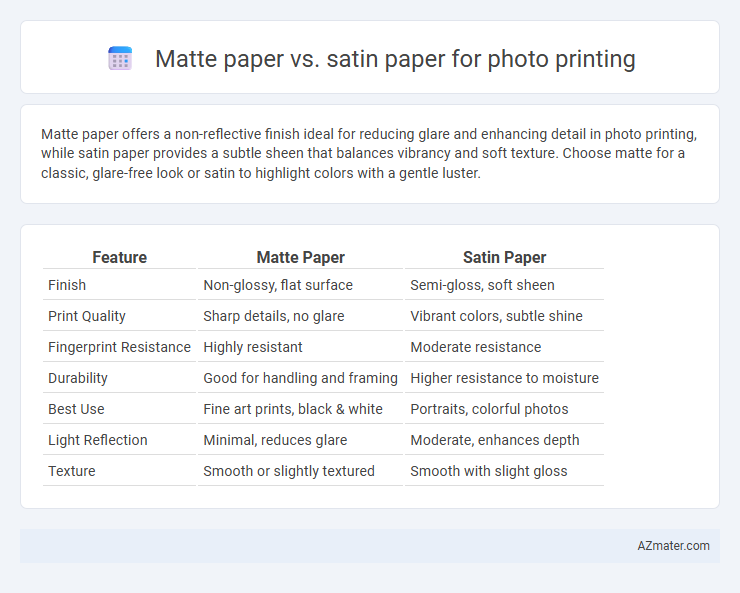Matte paper offers a non-reflective finish ideal for reducing glare and enhancing detail in photo printing, while satin paper provides a subtle sheen that balances vibrancy and soft texture. Choose matte for a classic, glare-free look or satin to highlight colors with a gentle luster.
Table of Comparison
| Feature | Matte Paper | Satin Paper |
|---|---|---|
| Finish | Non-glossy, flat surface | Semi-gloss, soft sheen |
| Print Quality | Sharp details, no glare | Vibrant colors, subtle shine |
| Fingerprint Resistance | Highly resistant | Moderate resistance |
| Durability | Good for handling and framing | Higher resistance to moisture |
| Best Use | Fine art prints, black & white | Portraits, colorful photos |
| Light Reflection | Minimal, reduces glare | Moderate, enhances depth |
| Texture | Smooth or slightly textured | Smooth with slight gloss |
Introduction to Matte and Satin Photo Papers
Matte photo paper features a non-glossy, smooth surface that reduces glare and fingerprints, making it ideal for professional portraits and fine art prints. Satin photo paper offers a subtle sheen that enhances color vibrancy and depth while maintaining a soft, elegant finish perfect for wedding or event photography. Both materials provide distinct tactile and visual qualities, catering to different aesthetic preferences and printing needs.
Key Differences Between Matte and Satin Paper
Matte paper offers a non-reflective surface with a smooth, flat finish that minimizes glare and fingerprints, ideal for artistic or fine detail photo prints. Satin paper provides a subtle sheen with a slight gloss, enhancing color vibrancy and contrast while maintaining moderate glare resistance. The choice between matte and satin paper depends on desired finish, color intensity, and display environment.
Texture and Feel: Matte vs Satin Paper
Matte paper offers a non-reflective, smooth texture that reduces glare and gives photos a soft, elegant feel, ideal for fine art prints or portraits. Satin paper provides a subtle sheen with a semi-gloss finish, enhancing color vibrancy while maintaining moderate glare control and a slightly textured surface. The choice between matte and satin paper significantly impacts the tactile experience and visual depth, with matte emphasizing subdued softness and satin balancing gloss with gentle texture.
Color Vibrancy and Image Sharpness
Matte paper offers a non-reflective finish that reduces glare, making colors appear softer and more muted, which can diminish vibrancy in photo printing. Satin paper balances between matte and glossy finishes, enhancing color vibrancy with a subtle sheen that boosts contrast and sharpness without excessive glare. For image sharpness, satin paper typically provides crisper detail due to its smoother surface, whereas matte paper may slightly diffuse fine details.
Reflection and Glare: Which Paper Performs Better?
Matte paper significantly reduces reflection and glare due to its non-glossy, textured surface, making it ideal for photo prints displayed under bright lighting conditions. Satin paper offers a subtle sheen that provides some gloss while minimizing glare, striking a balance between vivid color reproduction and moderate reflection control. For environments where controlling light reflection is critical, matte paper generally outperforms satin paper by delivering clearer visibility and less distracting glare.
Suitability for Different Photography Styles
Matte paper offers a non-glossy finish that reduces glare, making it ideal for black and white photography, portraits, and fine art prints that benefit from subtle tones and softer details. Satin paper provides a balance between glossy and matte finishes, delivering vibrant colors with minimal reflection, which suits landscape photography, vibrant portraits, and images requiring enhanced contrast and color depth. Choosing between matte and satin paper depends on the desired visual impact and the type of photograph, as each finish accentuates different aspects of the image's texture and color intensity.
Durability and Fingerprint Resistance
Matte paper offers excellent durability due to its robust coating that resists scratches and fading, making it ideal for long-lasting photo prints. Satin paper, while slightly less durable, provides better fingerprint resistance thanks to its smooth, semi-gloss finish that minimizes grease marks and smudges. Both options enhance photo quality, but matte excels in protecting prints from wear, while satin maintains cleaner surfaces with less visible fingerprints.
Cost Comparison: Matte vs Satin Paper
Matte paper generally costs less than satin paper due to its simpler coating process and lower production expenses, making it a more budget-friendly option for photo printing. Satin paper, while slightly more expensive, offers a smoother finish and enhanced color vibrancy that can justify the higher price for professional or premium prints. Choosing between matte and satin paper ultimately depends on balancing cost considerations with desired print quality and durability.
Best Uses and Recommendations
Matte paper offers a non-glossy, smooth finish ideal for art prints, black-and-white photography, and images requiring minimal glare, enhancing detail and color accuracy in brightly lit environments. Satin paper provides a subtle sheen that balances gloss and matte, making it suitable for portrait photography and vivid color prints where a slight shine enhances depth without overwhelming reflections. For archival purposes and professional presentations, matte paper is recommended to reduce fingerprints, while satin paper is preferred for vibrant images needing a polished yet understated finish.
Conclusion: Choosing the Right Paper for Your Prints
Matte paper offers a non-reflective finish ideal for reducing glare and enhancing fine detail, making it perfect for artistic and black-and-white photos. Satin paper provides a subtle sheen that balances vibrancy and texture, suitable for portraits and colorful images requiring rich color depth. Selecting the right paper depends on the desired visual effect and display environment, with matte excelling in soft, glare-free prints and satin enhancing color saturation and durability.

Infographic: Matte paper vs Satin paper for Photo printing
 azmater.com
azmater.com